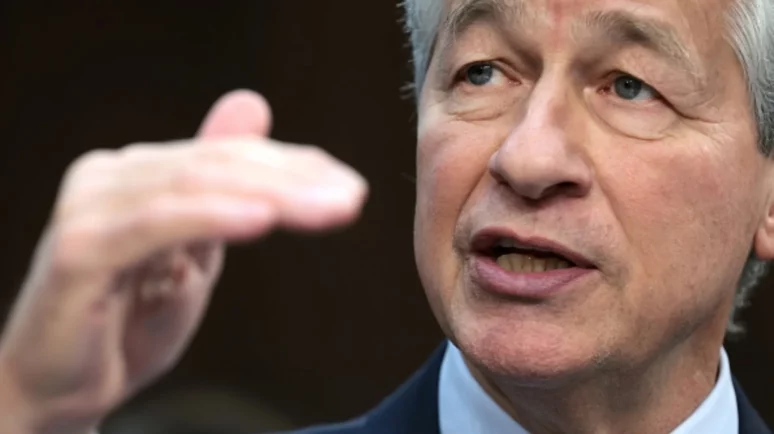JPMorgan’s Dimon Fears Fed May Rise Interest To 8% – Is He Right?

JPMorgan CEO Jamie Dimon said the Fed may increase rates to 8%. l Source: J. Lawler Duggan/For The Washington Post via Getty Images
Key Takeaways
- JPMorgan Chase CEO Jamie Dimon worries that the US Federal Reserve may raise interest rates further to combat inflation.
- So far, the expected slowdown in the US economy due to high borrowing costs has not materialized.
- Despite strong job growth, the Fed may still cut rates if inflation decelerates toward its target.
JPMorgan Chase’s CEO Jamie Dimon asserted that his bank can navigate potential interest rate spikes amid persistent inflationary pressures. The banker fears the US Federal Reserve may further increase the interest rates.
Yet, as US inflation showed signs of gradual deceleration after the pandemic, the prevailing anticipation is for the Federal Reserve to implement rate cuts later this year.
Dimon’s Warning On US Interest Rates
In his annual letter to shareholders, Jamie Dimon underscored JPMorgan Chase’s preparedness for a wide spectrum of interest rates, ranging from 2% to potentially exceeding 8%. These projections stem from concerns over heightened government expenditure and the imperative to mitigate inflationary pressures.
Dimon’s remarks coincide with US interest rates hovering between 5.25% and 5.5% – marking the highest levels in over two decades. Elevated interest rates, by amplifying borrowing costs, incentivize saving while curbing borrowing for both residential and commercial ventures. This, in turn, serves to temper economic activity and alleviate the forces propelling price escalation.
Dimon has persistently cautioned against undue optimism regarding a swift retreat of interest rates to lower thresholds. In the past, he even suggested the possibility of rates climbing to 7%.
The banker articulated: “All of the following factors appear to be inflationary: ongoing fiscal spending, remilitarization of the world, restructuring of global trade, capital needs of the new green economy, and possibly higher energy costs.”
But Market Expects Rate Cuts
Thus far, the anticipated dampening effect of elevated borrowing costs on the US economy has not materialized to the extent predicted. While certain sectors, notably housing, have experienced significant slowdowns, the unemployment rate remains below 4%. Moreover, buoyed by robust government and consumer spending, businesses continue to expand payrolls at a pace exceeding expectations.
Data released on Wednesday, April 10, 2024, by the Bureau of Labor Statistics revealed that US consumer price inflation accelerated more rapidly than forecasted in March. The year-on-year inflation rate surged to 3.5%, up from 3.2% in February, surpassing the Federal Reserve’s 2% target. Expectations had pegged the increase in consumer price inflation at just 3.4%, according to consensus from FXStreet.
According to LSEG data , futures traders have scaled back their expectations regarding the extent of the Federal Reserve‘s rate cuts this year. It marked the lowest levels seen since October. This adjustment comes in light of ongoing indications of robustness within the US economy.
Fed funds futures contracts for December indicate approximately 60 basis points in rate reductions for the year. This is a notable decrease from the 150 basis points anticipated at the outset of 2024. Furthermore, data from CME Group show that the likelihood of an initial 25 basis point cut in June stood at 49%. This compares with 57% in the previous week.
According to the CME Group’s FedWatch Tool , the chance of the Federal Reserve keeping the current rate range of 525/550 basis points at the May meeting is at 96%. Conversely, the probability of a 25 basis points cut within the 500/525 basis points target is currently priced at 4%. Looking ahead to the June meeting, futures indicate a 25 basis point cut with a likelihood of around 16%, down from 59% just a week prior.
What Will The Fed Do?
Fed Chair Jerome Powell emphasized the necessity for policymakers to ascertain a steady deceleration of inflation toward the Fed’s 2% target. This emphasis has heightened the significance of monthly inflation reports. These could dictate the timing and magnitude – or even the possibility – of Federal Reserve rate reductions throughout the year. Such rate cuts would gradually lower borrowing costs for both businesses and consumers and could potentially stimulate a surge in the stock market.
The inflationary surge triggered by the pandemic led to notable increases in the prices of essentials such as food, gasoline, and rent, among others. Although inflation has receded from its peak of 9.1% in June 2022, average prices remain considerably higher than pre-pandemic levels.
During a recent news conference, Powell clarified that robust hiring alone wouldn’t necessitate the Fed to postpone rate cuts. He pointed out that despite strong job growth last year, inflation continued to decline. This was largely due to an influx of available workers, primarily through increased immigration.
However, some policymakers have expressed reservations based on recent data. Lorie Logan, Chair of the Fed of Dallas, said it’s premature to contemplate rate cuts. Regardless of the Fed’s decision on May 1, it seems unlikely to align with Dimon‘s concerns regarding an imminent rise in interest rates.


